- お役立ち記事
- Fundamentals of rotor dynamics and measures to suppress vibration using sliding bearings
月間76,176名の
製造業ご担当者様が閲覧しています*
*2025年3月31日現在のGoogle Analyticsのデータより

Fundamentals of rotor dynamics and measures to suppress vibration using sliding bearings

目次
Understanding Rotor Dynamics
Rotor dynamics is a branch of applied mechanics that deals with the behavior and motion of rotors or rotating bodies.
Rotors are integral components of many machines such as turbines, compressors, jet engines, and electric motors.
Under operation, these rotors experience various dynamic forces that can lead to vibrations.
Understanding these dynamics is crucial for the effective design and operation of rotating machinery.
The primary factors influencing rotor dynamics include rotational speed, mass distribution, stiffness, and damping.
When a rotor spins, it experiences forces due to imbalance, misalignment, and external disturbances.
These forces can result in vibrations that range from harmless to damaging.
Engineers focus on understanding and predicting these vibrations to ensure machinery operates smoothly and efficiently.
Causes of Rotor Vibrations
Rotor vibrations can arise from several causes.
One of the most common causes is imbalance, which occurs when the mass distribution of the rotor is not symmetrical.
Even a slight imbalance can lead to significant vibrations at high speeds.
Misalignment is another major cause, occurring when the rotational axis of the rotor does not align perfectly with the intended axis of rotation.
This discrepancy can result in vibrations that stress mechanical components and lead to inefficiencies and wear.
Additionally, external forces, such as those from attached machinery or sudden load changes, can also introduce vibrations into the rotor system.
Other contributing factors include mechanical looseness, wear, and changes in system operating conditions.
The Role of Sliding Bearings in Rotor Dynamics
Sliding bearings, often known as plain bearings, play a crucial role in rotor dynamics by providing smooth operation and supporting rotational motion.
They consist of a bearing surface that slides over a matching surface, allowing for low-friction motion.
These bearings are commonly used in various machines due to their simplicity and cost-effectiveness.
In rotor systems, sliding bearings are particularly important for damping vibrations.
They can absorb and dissipate energy from undesired vibrations, reducing the stress on machinery and increasing its operational lifespan.
Advantages of Sliding Bearings
Sliding bearings offer several advantages for rotor dynamics.
First, they have a simple construction with fewer moving parts compared to other types of bearings, reducing potential points of failure.
This simplicity often translates to cost savings in both production and maintenance.
Another advantage is their ability to handle heavy loads without deformation.
Sliding bearings distribute loads over a larger surface area, reducing contact stress and increasing their capacity to support rotor weight.
Sliding bearings are also beneficial for handling misalignment.
Their internal clearance and self-aligning properties allow them to accommodate minor misalignments, reducing the impact on rotor dynamics.
Suppressing Vibration Using Sliding Bearings
Suppressing vibration in rotor systems is essential for maintaining performance and reliability.
Engineers employ various measures using sliding bearings to mitigate vibration effects.
One effective method is ensuring proper lubrication.
Lubricants form a thin film between the bearing surfaces, reducing friction and wear.
Proper lubrication also helps dissipate heat generated by friction and minimizes vibration by maintaining smooth surface interactions.
Another approach is optimizing the bearing load capacity.
Engineers can select bearings that match the anticipated loads of the rotor system, ensuring adequate support without excessive stress.
Sliding bearings can also be designed with grooves or patterns on the bearing surface to improve the hydrodynamic lubrication effect.
This design enhances the load-carrying capacity and damping properties of the bearing.
Design Considerations
Designing rotor systems with sliding bearings requires careful attention to several factors.
Material selection is critical, as bearing materials must withstand operating conditions and resist wear.
Common materials include bronze, composites, and certain plastics.
Bearing clearance is another important consideration.
Proper clearance ensures effective lubrication while accommodating thermal expansion and contraction during operation.
The installation process must also be precise, ensuring alignment and fit within the mechanical system to prevent undue stress and misalignment-related vibration.
Maintaining Rotor Dynamics with Sliding Bearings
Effective maintenance practices for sliding bearings contribute to sustaining rotor system dynamics.
Regular inspection and lubrication are essential to keep bearings in optimal condition.
Engineers should monitor bearing wear, surface condition, and alignment to detect potential issues early.
Implementing predictive maintenance techniques, such as vibration analysis and temperature monitoring, can also help identify problems before they lead to machinery failure.
Future Trends in Rotor Dynamics
Advancements in materials and technology continue to enhance the performance of sliding bearings in rotor dynamics.
Developments in composite materials, coatings, and manufacturing processes offer improved wear resistance and lower friction.
Incorporating sensors and smart technologies into rotor systems provides real-time monitoring and predictive maintenance capabilities.
These innovations enable proactive maintenance, reducing downtime and improving overall system efficiency.
In conclusion, understanding rotor dynamics and implementing measures to suppress vibrations using sliding bearings are key to enhancing the performance and longevity of rotating machinery.
With ongoing advancements in technology, engineers can look forward to improved solutions for managing rotor dynamics in various applications.
 資料ダウンロード
資料ダウンロード
QCD管理受発注クラウド「newji」は、受発注部門で必要なQCD管理全てを備えた、現場特化型兼クラウド型の今世紀最高の受発注管理システムとなります。
 ユーザー登録
ユーザー登録
受発注業務の効率化だけでなく、システムを導入することで、コスト削減や製品・資材のステータス可視化のほか、属人化していた受発注情報の共有化による内部不正防止や統制にも役立ちます。
 NEWJI DX
NEWJI DX
製造業に特化したデジタルトランスフォーメーション(DX)の実現を目指す請負開発型のコンサルティングサービスです。AI、iPaaS、および先端の技術を駆使して、製造プロセスの効率化、業務効率化、チームワーク強化、コスト削減、品質向上を実現します。このサービスは、製造業の課題を深く理解し、それに対する最適なデジタルソリューションを提供することで、企業が持続的な成長とイノベーションを達成できるようサポートします。
 製造業ニュース解説
製造業ニュース解説
製造業、主に購買・調達部門にお勤めの方々に向けた情報を配信しております。
新任の方やベテランの方、管理職を対象とした幅広いコンテンツをご用意しております。
 お問い合わせ
お問い合わせ
コストダウンが利益に直結する術だと理解していても、なかなか前に進めることができない状況。そんな時は、newjiのコストダウン自動化機能で大きく利益貢献しよう!
(β版非公開)









